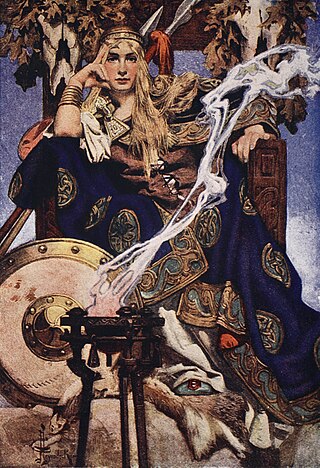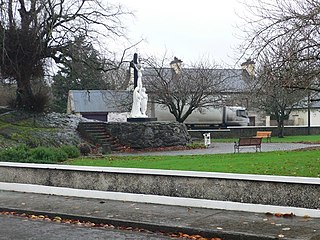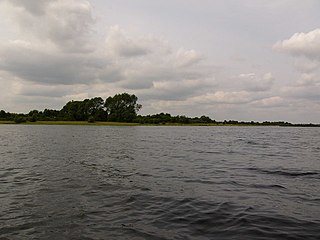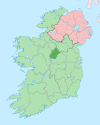
Medb, later spelled Meadhbh, Méabh(a) and Méibh, and often anglicised as Maeve, is queen of Connacht in the Ulster Cycle of Irish mythology. Her husband in the core stories of the cycle is Ailill mac Máta, although she had several husbands before him who were also kings of Connacht. She rules from Cruachan. She is the enemy of Conchobar mac Nessa, king of Ulster, and is best known for starting the Táin Bó Cúailnge to steal Ulster's prize stud bull Donn Cúailnge.

Lough Ree, translated to English as King's Lake or King Lake, is a lake in the midlands of Ireland, the second of the three major lakes on the River Shannon. Lough Ree is the second largest lake on the Shannon after Lough Derg. The other two major lakes are Lough Allen to the north, and Lough Derg to the south. There are also several minor lakes along the length of the river. The lake serves as a border between the counties of Longford and Westmeath on the eastern side and County Roscommon in the province of Connacht on the western side. The lake is popular for fishing and boating. The lake supports a small commercial eel fishery and is locally famous for its eels on wheels truck. The town of Athlone is situated at the southern end of the lake, and has a harbour for boats going out on the lake. The small town of Lanesboro is at the northern end of the lake.

Uí Fhiachrach Aidhne was a kingdom located in what is now the south of County Galway.

William de Burgh was the founder of the House of Burgh in Ireland and elder brother of Hubert de Burgh, 1st Earl of Kent and Geoffrey de Burgh, Bishop of Ely. William is often given the epithet, "the conqueror", but is not to be confused with the English king of the same nickname.
Toirdhealbhach Mór Ua Conchobhair anglicised Turlough Mór O'Conor, was King of Connacht (1106–1156) and High King of Ireland.

Tuamgraney is a village in eastern County Clare in the west of Ireland and a civil parish by the same name. Situated a kilometre from the River Graney which flows into Lough Derg, it is an ancient settlement, noted for St Cronán's Church, said to be the oldest church in constant use in Ireland

Clonfert Cathedral is a cathedral of the Church of Ireland in Clonfert, County Galway in Ireland. Previously the cathedral of the Diocese of Clonfert and then one of three cathedrals in the United Dioceses of Limerick and Killaloe, it is now one of five cathedrals in the Diocese of Tuam, Limerick and Killaloe.
Saint Diarmaid the Just was a Catholic abbot of Inis Clothrann (Inchcleraun), Lough Ree, County Longford and of Faughalstown, County Westmeath and a famous Irish confessor of the late-sixth century.
Newtowncashel is a village located near Lough Ree in County Longford, Ireland. Newtowncashel won the Irish Tidy Towns Competition in 1980.
Events from the year 1101 in Ireland.

Furbaide Ferbend is a character from the Ulster Cycle of Irish mythology. Legend has it that Furbaide Ferbend was buried in a passage grave atop Carn Clonhugh, more commonly known as Corn Hill or Cairn Hill, north Longford, after the two passage graves that crown the summit.
Domnall Mór Ua Briain, or Domnall Mór mac Toirrdelbaig Uí Briain, was King of Thomond in Ireland from 1168 to 1194 and a claimant to the title King of Munster. He was also styled King of Limerick, a title belonging to the O'Brien dynasty since Brian Boru's sacking of the Hiberno-Norse city state after the Battle of Sulcoit in the 10th century.
The Conmhaícne Mheáin Maigh or Conmaicne Mhein or Conmaicne Máenmaige or Conmaicne Críche Meic Erca were an early people of Ireland, their tuath comprising the barony of Loughrea, in County Galway.
Ó Beigléighinn or Beglin was the name of a hereditary medical family of County Longford.
The Three Tuathas was a name of a kingdom consisting of three kingdoms in County Roscommon, Ireland lying between Elphin and the River Shannon. It extended from Jamestown on the River Shannon to the north portion of Lough Ree. It was divided into three kingdoms known as Cenél Dobtha between Slieve Bawn and the River Shannon; Corca Achlann to the west and Tir Briuin na Sinna to the north. The O'Monaghan's and O'Boyle's were rulers of the Three Tuathas in the 13th century.
Cormac Mac Cárthaigh was a Gaelic Irish ruler who was King of Munster. A member of the Mac Cárthaigh clan of the Eóganacht Chaisil, he was the final king of the unified Kingdom of Munster before the realm was divided into the Kingdom of Desmond and Kingdom of Thomond in the aftermath of the Treaty of Glanmire.

Inis Cealtra, also known in English as Inishcaltra or Holy Island, is an island off the western shore of Lough Derg in Ireland. Now uninhabited, it was once a monastic settlement. It has an Irish round tower, and the ruins of several small churches, as well as four high crosses and a holy well. Despite the lack of population, the cemetery on this island is still in use. Coffins and mourners are transported the short distance from County Clare in small boats. Boat trips can be taken from the harbour at Mountshannon. It is conserved by the East Clare Heritage Centre.

Inchbofin is an island situated in Lough Ree on the River Shannon, in central Ireland.

Inchagoill is an island in Lough Corrib, Ireland. Its Christian ruins constitute an Irish National Monument. The island name means "Island of the devout foreigner."
Toirdhealbhach mac Diarmada Ua Briain was King of Munster in an interrupted reign from 1142 to 1165.













